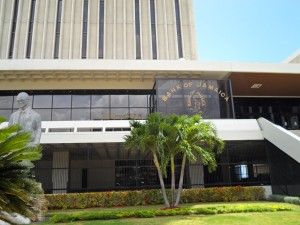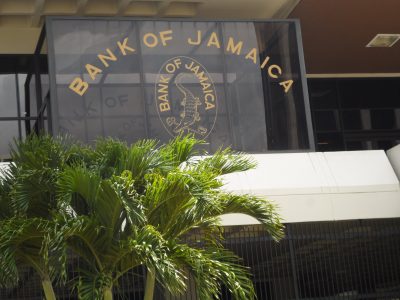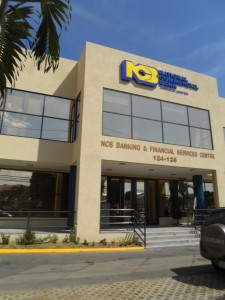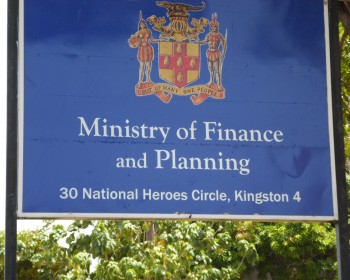Investors garnered interest rates as high as 11 percent on long term bonds issued by the Government of Jamaica last week auctions of three long term bonds that were reopened and raised $10 billion. The average rates were more moderate, with the highest average being 8 percent.
 The Government also offered $5 billion of the 10 percent bond due 2037 with a duration of 15.5 years. The auction attracted $6.759 billion that resulted in an average yield of 7.9614 percent. The lowest rate was 6.7 percent for $50 million and the highest success rate was 10 percent. The highest submitted bid was 12.999 percent. A total of 56 bids went after the bond, with 46 being successful.
The Government also offered $5 billion of the 10 percent bond due 2037 with a duration of 15.5 years. The auction attracted $6.759 billion that resulted in an average yield of 7.9614 percent. The lowest rate was 6.7 percent for $50 million and the highest success rate was 10 percent. The highest submitted bid was 12.999 percent. A total of 56 bids went after the bond, with 46 being successful.
The 5.675 percent bond due 2029, with a duration of 7.5 years, ended with an average yield of 6.3506 percent. The auction attracted $2.727 billion, of which $1 billion was allocated. The lowest rate was 5.575 percent for $100 million and the highest success rate was 6.94 percent. The highest submitted bid was 11 percent. This instrument received 43 submissions, with only 18 being successful.
The 4.5 percent bond due 2025, with a duration of 3.5 years, delivered an average yield of 6.2329 percent. Bids from 51 applicants amounting to $4.779 billion chased the $4 billion on offer. Only 44 bids succeeded in getting allocated. The lowest rate was 4.5 percent for $44 million, with the highest success rate of 10.525 percent. The highest submitted bid was 11 percent covering $100 million.
The increased rates come against the background of recent moves by Jamaica’s central bank to hike rates and move towards an era of positive interest rates. Since making their intention known, the bank raised its overnight rate from 0.50 percent to 2 percent in September and November, while rates on 30 days CDs moved to 4.11 percent from 0.59 percent since the beginning of August and 2.15 percent at the September 22 Auction.
BOJ one year CDs 2.74%
 Bank of Jamaica’s one-year CD offering of $4.5 billion on Thursday, October 21, ended with an average interest rate of 2.74 percent, much lower than the 4.53 percent the 30 days CD cleared at this past week.
Bank of Jamaica’s one-year CD offering of $4.5 billion on Thursday, October 21, ended with an average interest rate of 2.74 percent, much lower than the 4.53 percent the 30 days CD cleared at this past week.
The one year instrument attracted 107applications amounting to $15.88 billion, of which only 27 were successful. The highest bidding rate was 8.99 percent for $423 million, but the highest successful rate was 4.76 percent, resulting in 29.4 percent of the amount applied for being accepted by the Bank of Jamaica. The highest rate payable on the full amount of $140 million applied for was 4.5 percent, while the lowest rate applied for was 1.495 percent on $400 million.
The issue is likely to be regarded by the country’s central bank as highly successful. The success of the issue should result in more longer term offerings to lock up liquidity in the market on a longer term basis than the 30 days instruments that are more costly for the bank and more challenging to manage as they mature on a more frequent basis.
Jamaica is now seeing rising interest rates following the Central Bank’s decision in August to raise as a result of surging inflation. Following that decision, 30 day CD rates climbed sharply and the Bank raised its Overnight rate from 0.50 percent to 1.5 percent in September.
Bank of Jamaica hikes ON rate to1.5%
 Bank of Jamaica, the central Bank of Jamaica day raise their Over Night interbank rate by one percentage to 1.5 percent. The rise follows the Bank’s announcement at the end of August that the announced the decision to consider commencing a tightening of monetary policy at the next meeting of the Bank’s Monetary Policy Committee in September and to immediately implement other measures aimed at moderating inflation expectations, including the containment of Jamaican dollar liquidity expansion.
Bank of Jamaica, the central Bank of Jamaica day raise their Over Night interbank rate by one percentage to 1.5 percent. The rise follows the Bank’s announcement at the end of August that the announced the decision to consider commencing a tightening of monetary policy at the next meeting of the Bank’s Monetary Policy Committee in September and to immediately implement other measures aimed at moderating inflation expectations, including the containment of Jamaican dollar liquidity expansion.
A precursor to the policy rate increase and further tightening of the financial market, the CDs offered by the BOJ on September 29 resulted in a continuation in the rise of CD rates to 2.59 percent from 0.59 percent at the end of July.
The overnight rate was last cut to 0.50 percent in August 2019. It remained at that level up to the end of September. It ultimately dragged other rates in the system down and resulted in significant savings in interest costs for the government.
Consistent with meeting its inflation target sustainably in the medium term, the MPC agreed to continue increasing the Bank’s policy rate and by extension raising real interest rates, which are currently significantly negative and maintaining or intensifying the accompanying measures. This position is subject to inflation and other macroeconomic data evolving as projected.
T-Bill plunged to lowest rates on record
In the latest Government of Jamaica Treasury bill (T-bill) auction, for April, rates hit their lowest level on record. The fall reversed the sharp uptick in rates at the March auction, with the average rate for the half-year instrument then hitting 2.01 percent and the three months 1.87 percent.
 At the April auction, T-bill rates dropped to 1.08 percent for the 91 days Treasury bills, while the 182 days instrument ended with an average of just 1.05 percent. The rate for the 273 days instrument, averaged 1.73 percent.
At the April auction, T-bill rates dropped to 1.08 percent for the 91 days Treasury bills, while the 182 days instrument ended with an average of just 1.05 percent. The rate for the 273 days instrument, averaged 1.73 percent.
In March, the demand dropped sharply to just $1.05 billion, for the half T-bills, the amounts applied for falling from $2.32 billion to $1.41 billion, in April, $2.46 billion chased after the $700 million on offer for the 90 days instrument, $2 billion went after the 181 days note and $1.5 billion chased down the 270 days bills. In each case, the GOJ offered $700 million to the public.
BOJ holds policy rate
 Bank of Jamaica maintains the policy interest rate at 2.75 percent, the central bank stated on Tuesday. The rate is paid by the central for the placement funds overnight placements with Bank of Jamaica and helps in guiding the setting of rates in the wider economy.
Bank of Jamaica maintains the policy interest rate at 2.75 percent, the central bank stated on Tuesday. The rate is paid by the central for the placement funds overnight placements with Bank of Jamaica and helps in guiding the setting of rates in the wider economy.
“This policy stance reflects the Bank’s assessment that headline inflation for the next eight quarters should remain within the target of 4 percent to 6 percent, with the risks assessed to be balanced. Over the next three quarters, inflation is expected to track close to the lower bound of the target, primarily reflecting a decline in food prices as a result of a recovery in agricultural supplies. Thereafter, headline inflation is expected to converge towards the centre of the target,” the central bank stated.

Jamaica’s Central Bank in downtown Kingston.
“The outlook for inflation continues to be underpinned by the expectation that the Government will maintain a strong fiscal performance in alignment with the fiscal rules. There remains a risk that GDP growth will be slower than anticipated given the influence of external events.”
Bank of Jamaica stated that the “decision to maintain an accommodative policy stance is aimed at supporting further credit expansion and faster GDP growth. When adjusted for expected inflation, the policy rate remains negative in real terms in a context of high liquidity in financial markets. These conditions are considered to be appropriate at this time given the weaker-than-desirable pace of credit expansion. The policy stance has supported downward adjustments to yields on medium and long-term GOJ bonds in recent times and these downward adjustments are expected to flow through to loan rates.
Jamaica’s macroeconomic indicators remain positive. Inflation expectations remain low and anchored around Bank of Jamaica’s target, international reserves are increasing, the current account of the balance of payments is low and projected to remain at sustainable levels, market interest rates are falling and fiscal performance continues to be strong.”
 At the beginning of August, when the total amount of CDs was $35 billion, BOJ offered just $8 billion into the market and resulted in bids of $20.22 billion and resulted in an average interest rate of 0.59 percent, with the highest successful bid ending with a yield of just 0.62 percent, just higher than the banks overnight rate of 0.50 percent.
At the beginning of August, when the total amount of CDs was $35 billion, BOJ offered just $8 billion into the market and resulted in bids of $20.22 billion and resulted in an average interest rate of 0.59 percent, with the highest successful bid ending with a yield of just 0.62 percent, just higher than the banks overnight rate of 0.50 percent.








